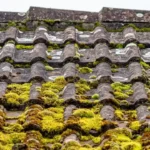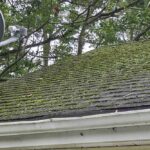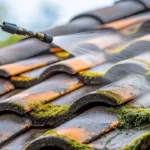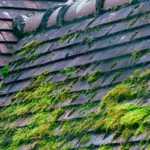As a homeowner, understanding the nuances of roof maintenance is crucial. One often overlooked aspect is roof moss. This seemingly harmless plant can lead to significant damage if not managed properly. In this article, we’ll explore essential roof moss facts homeowners should know to protect their investments.

What is Roof Moss?
Moss is a small, green plant that thrives in damp environments. On roofs, it often appears as a green, velvety layer. While it might seem innocuous, moss can trap moisture against roofing material, leading to decay over time.
Why Does Moss Grow on Roofs?
Moss tends to grow in shaded, moist areas. Roofs under trees or in climates with frequent rainfall are particularly susceptible. The north side of a roof, which receives less sunlight, is also more prone to moss growth. For more on how climate affects moss growth, see coastal climates.
The Effects of Roof Moss
Beyond aesthetics, moss can cause shingles to lift, allowing water to seep beneath and cause leaks. It can also degrade roofing materials, shortening the lifespan of your roof. For a detailed understanding of these risks, visit foundation risks.
Preventing Moss Growth on Your Roof
Prevention is key. Regularly trim overhanging branches to allow sunlight to reach your roof. Ensure your roof is properly ventilated and gutters are clean to prevent moisture buildup.
Regular Roof Inspections
Conduct regular roof inspections to catch early signs of moss growth. This proactive approach can save you significant repair costs down the line. Learn more about the dos and don’ts of moss removal.
Safe Moss Removal Techniques
If you find moss on your roof, it’s essential to remove it carefully. Harsh chemicals or aggressive scrubbing can damage roofing materials. Instead, use a gentle brush and a solution of water and mild detergent.
Professional Moss Removal Services
For extensive moss growth, consider hiring professionals. They have the expertise and tools to remove moss safely without damaging your roof. Check out more about safety precautions during moss removal.
The Impact of Moss on Roof Warranties
Many homeowners are unaware that neglecting moss can void roof warranties. Regular maintenance and documentation of moss treatment can help maintain warranty coverage. For more information, visit roof warranties.
Environmental Considerations
While removing moss, consider the environmental impact. Avoid using harsh chemicals that can harm surrounding plants and wildlife. Always follow eco-friendly practices.
Long-term Roof Maintenance Strategies
Implementing a long-term maintenance plan can prevent moss and other issues. Schedule regular cleanings and inspections, and address any damage promptly.
Investing in Quality Roofing Materials
High-quality roofing materials are less susceptible to moss and other damage. Investing in durable materials can save costs in the long run.
Cost Implications of Moss Removal
The cost of moss removal varies based on the extent of growth and the method used. DIY solutions are cheaper but may not be as effective as professional services.
Weighing Costs vs. Benefits
While professional services may seem costly, they often provide lasting solutions, preventing further damage and saving money over time.
Conclusion: Proactive Roof Care
Understanding roof moss facts empowers homeowners to take proactive steps in roof maintenance. With regular care, the longevity and integrity of your roof can be preserved, ensuring a safe and secure home environment. For further insights, consider reading this external resource on roof moss implications.

FAQ
1. Can moss damage my roof?
Yes, moss can trap moisture against your roof, leading to decay and potential leaks.
2. How can I prevent moss growth?
Ensure your roof is exposed to sunlight, keep it clean, and conduct regular inspections.
3. Should I use chemicals to remove moss?
It’s best to avoid harsh chemicals. Opt for gentle cleaning solutions and consider professional services.
This article contains affiliate links. We may earn a commission at no extra cost to you.








